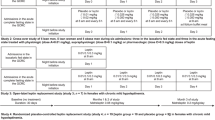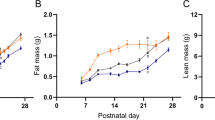Abstract
OBJECTIVE: When animals are allowed free access to food following an extended period of food restriction, body weight is steadily restored to the pre-food restriction level, ie to a specific body weight ‘set-point’. We tested the proposition that leptin is used as a signal by the brain to regulate body weight ‘set-point’. To this end, we determined whether long-term leptin infusion in rats would prevent the normal weight regain after food restriction.
METHODS: Male Sprague–Dawley rats received leptin (leptin-treated) or saline (vehicle-treated) by intravenous infusion. After a 2 week run-in period, food intake was adjusted to 50% of each individual's normal intake for 12 days. Two days prior to the return of unlimited access to food, one group of animals received continuous leptin infusion at 3 µg/h for the next 14 days. Blood samples taken from the tail vein were used to determine leptin concentrations. A third group of animals that did not undergo food restriction but received saline infusion served as control. As leptin acts in the brain to modulate neuropeptide Y (NPY) levels, hypothalamic NPY content was measured at the end of the study.
RESULTS: Food restriction to 50% normal intake for 12 days induced a 20% weight loss and significant reductions in plasma leptin compared with non-restricted control rats (0.5±0.1 vs 2.6±0.4 ng/ml, P<0.05). Intravenous infusion of leptin increased leptin concentrations four-fold compared with vehicle-treated animals (9.5±1.3 vs 2.2±0.4 ng/ml, P<0.05). The infusion of leptin attenuated the increase in daily food intake after free access to food was resumed (P<0.05 at 4, 6 and 8 days). Despite this, both groups of previously restricted rats had regained the same amount of weight after 12 days of ad libitum feeding. No difference was noted in NPY levels measured in the arcuate nucleus and the paraventricular nucleus, in line with the similar amounts of food eaten by all rats at the end of the experiment.
CONCLUSION: Increasing plasma leptin concentrations just prior to the end of a period of food restriction reduced subsequent food intake, but did not appear to exert a major influence on the body weight ‘set-point’, as leptin did not prevent weight regain. The results of the present study suggest that leptin may be of little value in maintaining weight loss in individuals who have lost weight through dieting. Further research is required to understand the role of leptin in the regulation of energy balance.
This is a preview of subscription content, access via your institution
Access options
Subscribe to this journal
Receive 12 print issues and online access
$259.00 per year
only $21.58 per issue
Buy this article
- Purchase on Springer Link
- Instant access to full article PDF
Prices may be subject to local taxes which are calculated during checkout




Similar content being viewed by others
References
Schwartz MW, Baskin DG, Kaiyala KJ & Woods SC . Model for the regulation of energy balance and adiposity by the central nervous system. Am J Clin Nutr 1999; 69: 584–596.
Hetherington AW & Ranson SW . Hypothalamic lesions and adiposity in the rat. Anatom Rec 1940; 78: 149–172.
Anand BK & Brobeck JR . Hypothalamic control of food intake in rats and cats. Yale J Biol Med 1951; 24: 123–140.
Mitchel JS & Keesey RE . Defense of lowered weight maintenance level by lateral hypothalamically lesioned rats: evidence from restriction feeding regimen. Physiol Behav 1977; 18: 1121–1125.
Mrosovsky N & Powley TL . Set points for body weight and fat. Behav Biol 1977; 20: 205–223.
Keesey RE & Hirvonen MD . Body weight set-points: determination and adjustment. J Nutr 1997; 127: 1875S–1883S.
Johnson D & Drenick EJ . Therapeutic fasting in morbid obesity. Arch Intern Med 1977; 137: 1381–1382.
Kennedy GC . The role of depot fat in the hypothalamic control of food intake in the rat. Proc R Soc Lond B Biol Sci 1953; 140: 579–592.
Ingalls AM, Dickie MM & Shell GG . Obesity, a new mutation in the house mouse. J Hered 1950; 41: 317–318.
Coleman DJ . Effects of parabiosis of obese with diabetes and normal mice. Diabetologia 1973; 9: 294–298.
Zhang Y, Proenca R, Maffei M, Barone M, Leopold L & Friedman JM . Positional cloning of the mouse obese gene and its human homologue. Nature 1994; 372: 425–432.
Maffei M, Halaas J, Ravussin E, Pratley RE, Lee, GH, Zhang Y, Fei H, Kim S, Lallone R, Ranganathan S, Kern PA & Friedman JM . Leptin levels in human and rodent: measurement of plasma leptin and ob RNA in obese and weight-reduced subjects. Nat Med 1995; 1: 1155–1161.
Frederich RC, Hamann A, Anderson S, Lollmann B & Flier JS . Leptin levels reflect body content in mice: evidence for diet induced resistance in leptin action. Nat Med 1995; 1: 1311–1314.
Considine RV, Sinha MK, Heiman ML, Kriauciunas A, Stephens TW, Nyce MR, Ohannesian JP, Marco CC, McKee LJ & Bauer TL . Serum immunoreactive-leptin concentrations in normal-weight and obese humans. New Engl J Med 1996; 334: 292–295.
Houseknecht KL, Mantzoros CS, Kuliawat R, Hadro E, Flier JS & Kahn BB . Evidence of leptin binding to proteins in serum of rodents and humans: modulation with obesity. Diabetes 1996; 45: 1638–1643.
Banks WA, Kastin AJ, Huang W, Jaspan JB & Maness LM . Leptin enters the brain by a saturable system independent of insulin. Peptides 1996; 17: 305–311.
Tartaglia L, Dembski M, Weng X, Deng N, Culpper J, Devos R, Richards GJ, Campfield LA, Clark FT, Deeds J, Muir C, Sanker S, Moriarty A, Moore KJ, Moore KJ, Smutko JS, Mays GG, Woolf EA, Monroe CA & Tepper RT . Identification and expression cloning of a leptin receptor. Cell 1995; 83: 1263–1271.
Schwartz MW, Seeley RJ, Campfield LA, Burn P & Baskin DG . Identification of targets of leptin action in the rat hypothalamus. J Clin Invest 1996; 98: 1101–1106.
Saladin R, De Vos P, Guerre-Millo M, Leturque A, Girard J, Staels B & Auwerx J . Transient increase in obese gene expression after food intake and insulin administration. Nature 1995; 377: 527–529.
Kolaczynski JW, Considine RV, Ohannesian J, Marco C, Opentanova I, Nyce MR, Myint M & Caro JF . Responses of leptin to short-term fasting and refeeding in humans: a link with ketogenesis but not ketones themselves. Diabetes 1996; 45: 1511–1515.
Sinha MK, Ohannesian JP, Heiman ML, Kriauciunas A, Stephens TW, Magosin S, Marco C & Caro JF . Nocturnal rise of leptin in lean, obese and non-insulin-dependant diabetes mellitus subjects. J Clin Invest 1996; 97: 1344–1347.
Friedman JM & Halaas JL . Leptin and the regulation of body weight in mammals. Nature 1998; 395: 763–770.
Pelleymounter MA, Cullen MJ, Baker MB, Hecht R, Winters D, Boone T & Collins F . The effects of the obese gene product on body weight regulation in ob/ob mice. Science 1995; 269: 540–543.
Halaas JL, Gajiwala KS, Maffei M, Cohen SL, Chait BT, Rabinowitz D, Lallone RL, Burley SK & Friedman JM . Weight-reducing effects of the plasma protein encoded by the obese gene. Science 1995; 269: 543–546.
Campfield LA, Smith FJ, Guisez Y, Devos R & Burn P . Recombinant mouse OB protein: evidence for a peripheral signal linking adiposity and central neural networks. Science 1995; 269: 546–549.
Halaas JL, Boozer C, Blair-West J, Fidahusein N, Denton DA & Friedman JM . Physiological response to long-term peripheral and central leptin infusion in lean and obese mice. Proc Natl Acad Sci USA 1997; 94: 8878–8883.
Eiden S, Preibisch G & Schmidt I . Leptin responsiveness of juvenile rats: proof of leptin function within the physiological range. J Physiol 2001; 530: 131–139.
Flier JS . What's in a name? In search of leptin's physiological role. J Clin Endcrinol Metab 1998; 83: 1407–1413.
Ahima RS, Kelly J, Elmquist JK & Flier JS . Distinct physiologic and neural responses to decreased leptin and mild hyperleptinemia. Endocrinology 1999; 140: 4923–4931.
Hansen MJ, Ball MJ & Morris MJ . Enhanced inhibitory feeding response to alpha-melanocyte stimulating hormone in the diet-induced obese rats. Brain Res 2001; 892: 130–137.
Lee J & Morris MJ . Modulation of neuropeptide Y overflow by leptin in the rat hypothalamus, cerebral cortex and medulla. Neuro Report 1998; 9: 1575–1580.
Furness JB, Koopmans HS, Robbins HL, Clerc N, Tobin JM & Morris MJ . Effects of vagal and splanchic section on food intake, weight, serum leptin and hypothalamic neuropeptide Y in rat. Autonom Neurosci 2001; 92: 28–36.
Levin BE & Keesey RE . Defence of differing body weight set points in diet-induced obese and resistant rats. Am J Physiol 1998; 274: R412–R419.
Otukonyong EE, Okutani F, Takahashi S, Murata T, Morioka N, Kaba H & Higuchi T . Effect of food deprivation and leptin repletion on the plasma levels of estrogen (E2) and NAPDH-d reactivity in the ventromedial and arcuate nuclei of the hypothalamus in the female rats. Brain Res 2000; 887: 70–79.
Westerterp-Plantenga MS, Saris WH, Hukshorn CJ & Campfield LA . Effects of weekly administration of pegylated recombinant human OB protein on appetite profile and energy metabolism in obese men. Am J Clin Nutr 2001; 74: 426–434.
Harris RBS, Zhou J, Redmann SM Jr, Smagin GN, Smith SR, Rodgers E & Zachwieja JJ . A leptin dose-response study in obese (Ob/Ob) and lean (+/?) mice. Endocrinology 1998; 139: 8–19.
Wang J, Liu R, Liu L, Chowdury R, Barzilai N, Tan J & Rossetti L . The effect of leptin on Lep expression is tissue specific and nutritionally regulated. Nat Med 1999; 5: 895–899.
Beck B, Jhanwar-Uniyal M, Burlet A, Chapleur-Chateau M, Leibowitz SF & Burlet C . Rapid and localized alterations of neuropeptide Y in discrete hypothalamic nuclei with feeding status. Brain Res 1990; 528: 245–249.
Kalra SP, Dube MG, Sahu A, Phelps P & Kalra PS . Neuropeptide Y secretion in paraventricular nucleus in association with increased appetite for food. Proc Natl Acad Sci USA 1991; 88: 10931–10935.
Dhillon H, Kalra SP & Kalra PS . Dose-dependent effects of central leptin gene therapy on genes that regulate body weight and appetite in the hypothalamus. Mol Ther 2001; 4: 139–145.
Chiesi M, Huppertz C & Hofbauer KG . Pharmacotherapy of obesity: targets and perspectives. Trends Pharmac Sci 2001; 22: 247–254.
Farooqi IS, Jebb SA, Langmack G, Lawrence E, Cheetham CH, Prentice AM, Hughes IA, McCamish MA & O'Rahilly S . Effects of recombinant leptin therapy in child with congenital leptin deficiency. New Engl J Med 1999; 341: 879–884.
Heymsfield SB, Greenberg AS, Fujioka K, Dixon RM, Kushner R, Hunt T, Lubina JA, Patane J, Self B, Hunt P & McCamish M . Recombinant leptin for weight loss in obese and lean adults: a randomised, controlled, dose-escalation trial. JAMA 1999; 282: 1568–1575.
Acknowledgements
Professor Bevyn Jarrott generously provided NPY antiserum. This work was supported by a block grant to the Howard Florey Institute of Experimental Physiology and Medicine from the National Health and Medical Research Council of Australia (grant no. 98 3001) and grants from the Robert J Kleberg, Jr and Helen C Kleberg Foundation, the G Harold and Leila Y Mathers Charitable Foundation, the Rebecca L Cooper Medical Research Foundation, the Windemere Foundation and the Phillip Bushell Foundation.
Author information
Authors and Affiliations
Additional information
This work was presented in abstract form at the 35th Meeting of the Australasian Society of Clinical and Experimental Pharmacologists and Toxicologists, 2001.
Rights and permissions
About this article
Cite this article
Velkoska, E., Morris, M., Burns, P. et al. Leptin reduces food intake but does not alter weight regain following food deprivation in the rat. Int J Obes 27, 48–54 (2003). https://doi.org/10.1038/sj.ijo.0802193
Received:
Revised:
Accepted:
Published:
Issue Date:
DOI: https://doi.org/10.1038/sj.ijo.0802193
Keywords
This article is cited by
-
Low-intensity and moderate exercise training improves autonomic nervous system activity imbalanced by postnatal early overfeeding in rats
Journal of the International Society of Sports Nutrition (2014)
-
Interaction of Leptin and Amylin in the Long‐term Maintenance of Weight Loss in Diet‐induced Obese Rats
Obesity (2010)
-
Selective reduction in body fat mass and plasma leptin induced by angiotensin-converting enzyme inhibition in rats
International Journal of Obesity (2008)



